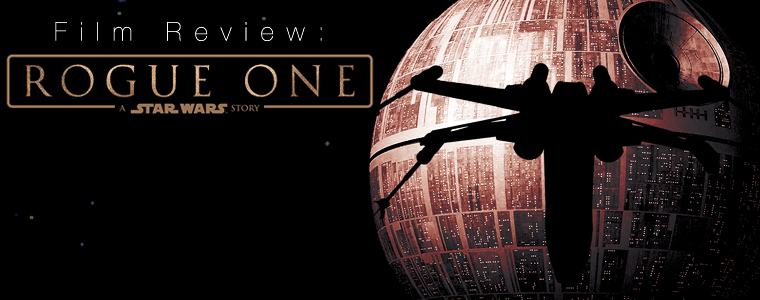A Little Rogue
by Andrew Collins
Here’s an interesting question: is Rogue One a true Star Wars film, or isn’t it?
Differentiated from the rest of the films in the beloved space opera saga by the descriptor, “A Star Wars story,” Rogue One breaks precedent with the rest of the Star Wars series in several notable ways. First and most obviously, it doesn’t make use of the signature opening crawl. It is also the only Star Wars film without a lightsaber battle, and the first to use text on the screen to inform the audience which planet is being shown.
It does, however, pay homage to rest of the series in many delightful ways. These include things like a cameo of C-3PO and R2-D2 (to ensure that the robotic duo appears in every Star Wars film) and shots deliberately showcasing the exotic, Mos-Eisely-cantina-like, marketplace on the desert moon of Jedha (including a pair of unsavories that Luke would later encounter at said cantina). Aesthetically it bridges the prequel trilogy and the original trilogy with grandiose shots of star destroyers dwarfed by the looming specter of the Death Star, CGI-supported appearances of Grand Moff Tarkin and Princess Leia, and of course plenty of X-Wings and TIE fighters.
Indeed, there’s simply no escaping the greatest strength of the Star Wars franchise: the vast scope and imaginative potential of George Lucas’s galaxy far, far away. With the old staples, plus plenty of new spaceships, aliens, planets, heroes, and villains, Rogue One invites the viewer to strap in for two-plus hours of high galactic adventure. The old magic that enchanted audiences nearly four decades ago with the release of the original Star Wars still runs deep.
As nice at it is return to the Star Wars universe, however, this critic had hopes that a spinoff like Rogue One would offer a more creative departure from past films. Unbound from the old episodic narrative, here was a chance to make an intergalactic heist film or tell a freewheeling adventure story in the vein of, say, the Firefly crew. Strangely enough, this may have been the initial goal of Rogue One. Judging by the film’s earliest trailers, there was a shift from the early vision of the story to what is now playing in theaters. We can only speculate about what might have been, but in light of the many reshoots that were done during production, it’s not surprising that Rogue One comes close to losing its way at times.
Put simply, what we’re left with is mostly just another Star Wars film, but without the two best things about Star Wars films: lightsaber duels and the opening crawl. It also doesn’t help that Rogue One’s action sequences run like something from the imagination of a Junior High boy. Stormtroopers get gunned down in abundance – video game style – and for far too long. Between these flurries of laser bolts and explosions, the story struggles to catch its breath, leaving little room for the heartfelt emotion that makes a film endure beyond the immediate experience of watching it.
These criticisms are not to suggest that the Rogue One isn’t interesting and thought-provoking at times. It is. After the opening sequence – a flashback explaining the origin of Rebel heroine Jyn Erso (Felicity Jones) – Rogue One begins in medias res by injecting a dose of realism into its portrayal of the Rebel cause. The Galactic Empire is undisputedly evil of course, knowing no level of oppression that isn’t worth imposing for the sake of order in the galaxy, but the black and white contrast of the original trilogy that pitted good guys versus bad guys – the Light Side against the Dark Side – suddenly takes on a grey hue. Our introduction to Rebel Captain Cassian Andor (Diego Luna), for instance, finds him shooting an informant in cold blood rather than risk his capture by Imperial forces. And the “radical” rebel band of Saw Gerrera (Forest Whitaker) are as suggestive of the Taliban as they are of any decidedly more noble cause. These moments of gritty dissonance surely reflect the experience of childhood fans of Star Wars who have since grown into a more jaded adulthood. Like any political movement that makes use of violence, the Rebellion is not without a few skeletons in its closet.
{SPOILERS}
The closest Rogue One comes to a stroke of brilliance is how it explains what is often criticized as a plot hole in A New Hope. How does firing a single proton torpedo down a tiny exhaust port lead to the destruction of a space station the size of a small moon? What imperial engineer in his right mind would build a reactor that unstable?
Thus might the nerd wonder, and it is a fair line of questioning. The weakness that Luke Skywalker exploited to destroy the first Death Star once stretched the rules of probability and necessity governing good stories, but no longer. Rogue One shows how the Empire forced the scientist Galen Erso (Mads Mikkelsen) to help design the Death Star. Rather than refuse the Empire’s demands and die, Erso complied so that he could secretly build a trap into the very heart of the Death Star, a tiny vulnerability no one would spot.
So take that, haters. The first Death Star had that stupid weakness because a rogue Imperial scientist put it there. If Rogue One accomplishes nothing else, it at least allows us to watch the rest of the Star Wars films with a little more peace.








